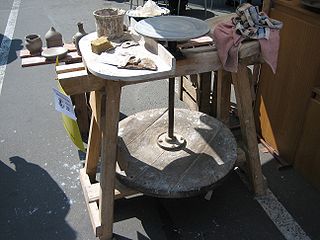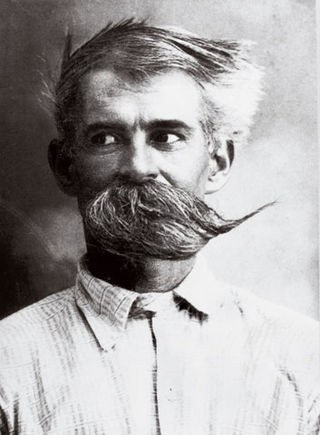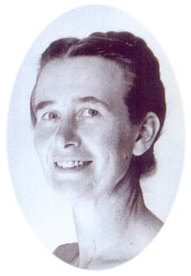Related Research Articles

Pottery and porcelain is one of the oldest Japanese crafts and art forms, dating back to the Neolithic period. Kilns have produced earthenware, pottery, stoneware, glazed pottery, glazed stoneware, porcelain, and blue-and-white ware. Japan has an exceptionally long and successful history of ceramic production. Earthenwares were made as early as the Jōmon period, giving Japan one of the oldest ceramic traditions in the world. Japan is further distinguished by the unusual esteem that ceramics hold within its artistic tradition, owing to the enduring popularity of the tea ceremony.

Bernard Howell Leach was a British studio potter and art teacher. He is regarded as the "Father of British studio pottery".

In pottery, a potter's wheel is a machine used in the shaping of clay into round ceramic ware. The wheel may also be used during the process of trimming excess clay from leather-hard dried ware that is stiff but malleable, and for applying incised decoration or rings of colour. Use of the potter's wheel became widespread throughout the Old World but was unknown in the Pre-Columbian New World, where pottery was handmade by methods that included coiling and beating.

George Edgar Ohr was an American ceramic artist and the self-proclaimed "Mad Potter of Biloxi" in Mississippi. In recognition of his innovative experimentation with modern clay forms from 1880 to 1910, some consider him a precursor to the American Abstract-Expressionism movement.

Shōji Hamada was a Japanese potter. He had a significant influence on studio pottery of the twentieth century, and a major figure of the mingei (folk-art) movement, establishing the town of Mashiko as a world-renowned pottery centre. In 1955 he was designated a "Living National Treasure".

Studio pottery is pottery made by professional and amateur artists or artisans working alone or in small groups, making unique items or short runs. Typically, all stages of manufacture are carried out by the artists themselves. Studio pottery includes functional wares such as tableware and cookware, and non-functional wares such as sculpture, with vases and bowls covering the middle ground, often being used only for display. Studio potters can be referred to as ceramic artists, ceramists, ceramicists or as an artist who uses clay as a medium.

Bizen ware is a type of Japanese pottery traditionally from Bizen province, presently a part of Okayama prefecture.
Regis Brodie is a tenured Professor of Art at the Department of Art and Art History at Skidmore College in Saratoga Springs, NY and a potter. Since 1972, he has been serving as the Director of the Summer Six Art Program at Skidmore College. He also wrote a book called The Energy Efficient Potter which was published by Watson-Guptill Publications in 1982. He started the Brodie Company in 1999 in the interest of developing tools which would aid the potter at the potter's wheel.
Tatsuzō Shimaoka was a Japanese mingei potter who studied under Shōji Hamada and later became the second Living National Treasure of Mashiko, Japan. He was best known for his unique Jōmon zogan style of pottery, and was a master of many slip decorating and firing techniques for pottery. Throughout his career, Shimaoka worked collaboratively with a group of workers, students, and apprentices from Japan and abroad. After supervising the loading of what would become his last noborigama firing in late 2007, Shimaoka collapsed, and died several weeks later in late 2007 from acute liver failure at Mashiko in Tochigi Prefecture.

Gwyn Hanssen Pigott OAM (1935–2013) was an Australian ceramic artist. She was recognized as one of Australia’s most significant contemporary artists. By the time she died she was regarded as "one of the world's greatest contemporary potters". She worked in Australia, England, Europe, the US, New Zealand, Japan and Korea. In a career spanning nearly 60 years, influences from her apprenticeships to English potters were still apparent in her later work. But in the 1980s she turned away from production pottery to making porcelain still-life groups largely influenced by the Italian painter Giorgio Morandi.

Newcomb Pottery, also called Newcomb College Pottery, was a brand of American Arts & Crafts pottery produced from 1895 to 1940. The company grew out of the pottery program at H. Sophie Newcomb Memorial College, the women's college now associated with Tulane University in New Orleans, Louisiana. The Pottery was a contemporary of Rookwood Pottery, the Saturday Evening Girls, North Dakota pottery, Teco and Grueby.
Ian Barry Brickell was a New Zealand potter, writer, conservationist and founder of Driving Creek Railway.
Jack Doherty is a Northern Irish studio potter and author. He is perhaps best known for his vessels made of soda-fired porcelain. He has been featured in a number of books, and his work has been exhibited widely in both Europe and North America. Articles of his have appeared in various pottery journals and he has been Chair of the Craft Potters Association.

Erica Deichmann Gregg was a Canadian studio potter. In the 1930s she and her first husband Kjeld Deichmann created Deichmann pottery, Canada's first studio pottery.
Ruth Gowdy McKinley was an American-born Canadian ceramic artist noted for her skill in designing functional ceramic ware. She specialized in making teapots, cups and vases.

John Parker Glick was an American ceramicist. Though open to artistic experimentation, Glick was most influenced by the styles and aesthetics of Asian pottery—an inspiration that shows in his use of decorative patterns and glaze choices. His experience working with ceramics led him to publish several articles about the craft. In addition to producing pottery, Glick began making "landscape oriented" wall panels during the latter part of his career. Known as "the people's potter," he is primarily remembered for his contributions to art and the field of ceramics.
Karl Martz was an American studio potter, ceramic artist, and teacher whose work achieved national and international recognition.

Denise Wren was an Australian-born British studio potter and craftsperson. Wren was one of the first female studio potters in Britain. She studied and taught with the Kingston School of Art, Knox Guild and Camberwell College of Arts. Wren and her family subsequently set up the Oxshott Pottery and wrote on the subjects of ceramics, textiles and making.
Mary Borgstrom was a Canadian potter, ceramist, and artist who specialized in primitive techniques. She was presented with the "Award of Excellence" by the Canadian Guild of Crafts in Quebec.
References
- 1 2 3 4 5 6 Inglis, Stephen (1991). The Turning Point: The Deichmann Pottery, 1935-1963 = Le tournant : la potterie Deichmann, 1935-1963. Hull, Quebec: Canadian Museum of Civilization = Musée canadien des civilisations. ISBN 0-660-50298-4.
- 1 2 3 Niergarth, Kirk (2015). "The Dignity of Every Human Being": New Brunswick Artists and Canadian Culture between the Great Depression and the Cold War. Toronto: University of Toronto Press. ISBN 978-1-4426-6320-6.
- 1 2 3 Gichuru, Anneke (31 July 2007). "Lives lived: Erica Deichmann Gregg". The Globe and Mail. Toronto. p. L8.
- 1 2 3 4 "The Deichmann Collection: Danish Influence on Canadian Crafts". Canadian Museum of History. Retrieved 2 March 2016.
- ↑ Inglis, Stephen (6 June 1991). "Curatorial statement: The Turning Point: The Deichmann Pottery (1935-1963)". Material Culture Review / Revue de la culture matérielle. 34 (1): 90–92.
The Deichmanns are widely acknowledged to be the first studio potters in Canada: that is, the first to set up a studio, kiln and other facilities, which enabled them to produce a personalized series of domestic and decorative art pottery as a means of making a living.
- 1 2 Gotlieb, Rachel (2008). "Married to pottery: A life of uncertainty". In Alan C. Elder; Jean Johnson; Melanie Egan (eds.). Crafting New Traditions: Canadian Innovators and Influences. Canadian Museum of Civilization. pp. 15–24. ISBN 978-0-660-19784-5.
- ↑ Gotlieb, Rachel (8 February 2006). "Contemporary ceramics". The Canadian Encyclopedia . Toronto: Historica Canada. Retrieved 5 March 2016.
- ↑ Peters, Donald (Director) (1953). The Story of Peter and the Potter. National Film Board. Retrieved 5 March 2016.
- ↑ Collins, John B. (6 June 1991). "Garth Clark, Robert Ellison and Eugene Hecht, The Mad Potter of Biloxi: The Art and Life of George E. Ohr ; American Craft Museum, George Ohr: Modern Potter (1857-1918) ; Canadian Museum of Civilisation, The Turning Point: The Deichmann Pottery (1935-1963)". Material Culture Review / Revue de la culture matérielle. 34 (1): 84–89. Retrieved 5 March 2016.